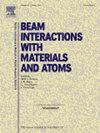Effect of argon ion irradiation on the electrical transport and electronic characteristics of Bi2Se3 single crystals
IF 1.4
3区 物理与天体物理
Q3 INSTRUMENTS & INSTRUMENTATION
Nuclear Instruments & Methods in Physics Research Section B-beam Interactions With Materials and Atoms
Pub Date : 2025-02-03
DOI:10.1016/j.nimb.2025.165633
引用次数: 0
Abstract
The electrical resistivity, Hall effect and magnetoconductivity of a Bi2Se3 topological insulator were studied before and after argon ion irradiation with fluences of 1.25∙1015 cm−2 and 1.25∙1017 cm−2 and energies of 10–15 keV at temperatures from 5 to 300 K in magnetic fields up to 9 T. Irradiation was found to lead to an increase in the electrical resistivity and a decrease in the current carrier concentration. In addition, it was found that the values of current carrier mobility, mean free path and magnetoconductivity do not change monotonically with the irradiation dose. It was suggested that the observed effects can be caused by both a change in the topology of the Fermi surface and the appearance of additional scattering centers as a result of irradiation.
氩离子辐照对 Bi2Se3 单晶的电输运和电子特性的影响
在温度为5 ~ 300 K、磁场强度为9 t、影响为1.25∙1015 cm−2和1.25∙1017 cm−2、能量为10 ~ 15 keV的情况下,研究了Bi2Se3拓扑绝缘体的电阻率、霍尔效应和导电性,发现辐照导致电阻率升高,载流子浓度降低。此外,发现电流载流子迁移率、平均自由程和磁导率的值不随辐照剂量的变化而单调变化。结果表明,观测到的效应可能是由于费米表面拓扑结构的变化和辐射引起的额外散射中心的出现引起的。
本文章由计算机程序翻译,如有差异,请以英文原文为准。
求助全文
约1分钟内获得全文
求助全文
来源期刊
CiteScore
2.80
自引率
7.70%
发文量
231
审稿时长
1.9 months
期刊介绍:
Section B of Nuclear Instruments and Methods in Physics Research covers all aspects of the interaction of energetic beams with atoms, molecules and aggregate forms of matter. This includes ion beam analysis and ion beam modification of materials as well as basic data of importance for these studies. Topics of general interest include: atomic collisions in solids, particle channelling, all aspects of collision cascades, the modification of materials by energetic beams, ion implantation, irradiation - induced changes in materials, the physics and chemistry of beam interactions and the analysis of materials by all forms of energetic radiation. Modification by ion, laser and electron beams for the study of electronic materials, metals, ceramics, insulators, polymers and other important and new materials systems are included. Related studies, such as the application of ion beam analysis to biological, archaeological and geological samples as well as applications to solve problems in planetary science are also welcome. Energetic beams of interest include atomic and molecular ions, neutrons, positrons and muons, plasmas directed at surfaces, electron and photon beams, including laser treated surfaces and studies of solids by photon radiation from rotating anodes, synchrotrons, etc. In addition, the interaction between various forms of radiation and radiation-induced deposition processes are relevant.

 求助内容:
求助内容: 应助结果提醒方式:
应助结果提醒方式:


